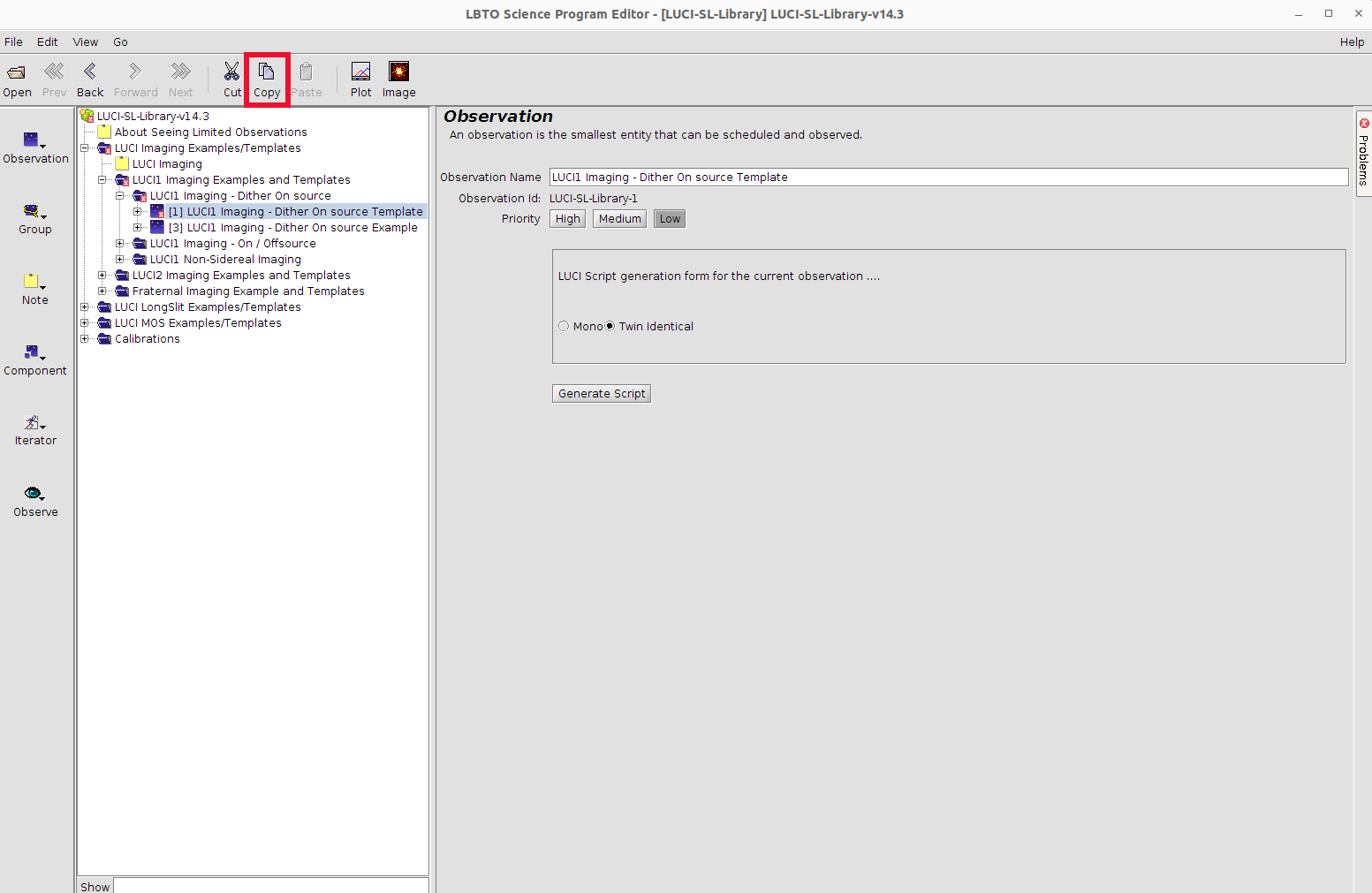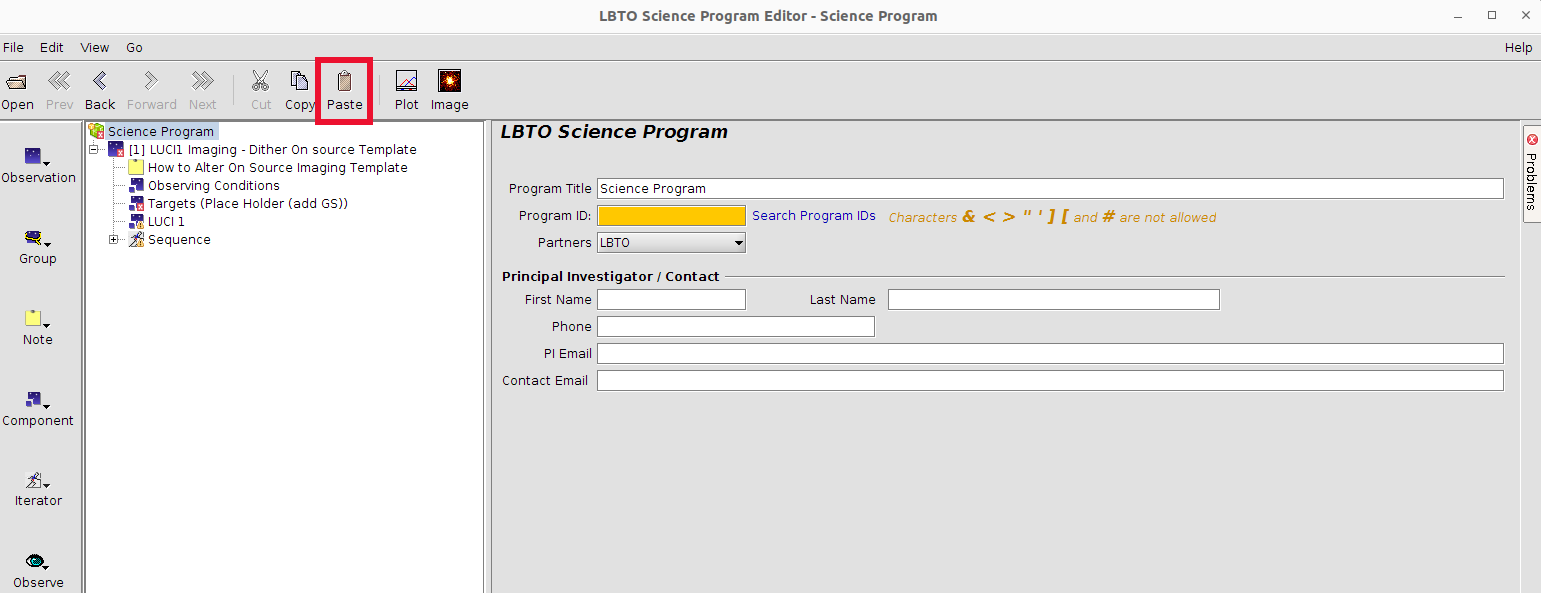1: Imaging Example
Example 1: Setting up LUCI Direct Imaging Observations
Expand the LUCI Imaging Examples/Templates Folder. This Folder contains Examples and Templates for both LUCI1 and LUCI2. LUCI Imaging Observations can be done in Seeing-Limited (SL), Enhanced-Seeing (ESM), or AO mode. There are separate libraries with templates for SL observations and ESM/AO observations. Expand the Folder for the desired LUCI. Only twining is available at this time for binocular imaging observations. Set your observation up with either the LUCI1 templates (expanding the LUCI1 Folder) or the LUCI2 templates (expanding the LUCI2 Folder) and twin that observation when generating the script. Script generation is described more here.
Highlight the Template and then click COPY in the Main Toolbar.
Back in the *empty* Science Program PASTE the observations by hitting PASTE in the Main Toolbar.
Tailor the Template with your Observation details following the tree of the Observation in the Template:
- Observation Element: Change the Observation Name from the generic template name to something descriptive. This can help observers easily identify observations in the OT Science Program if multiple observations are provided.
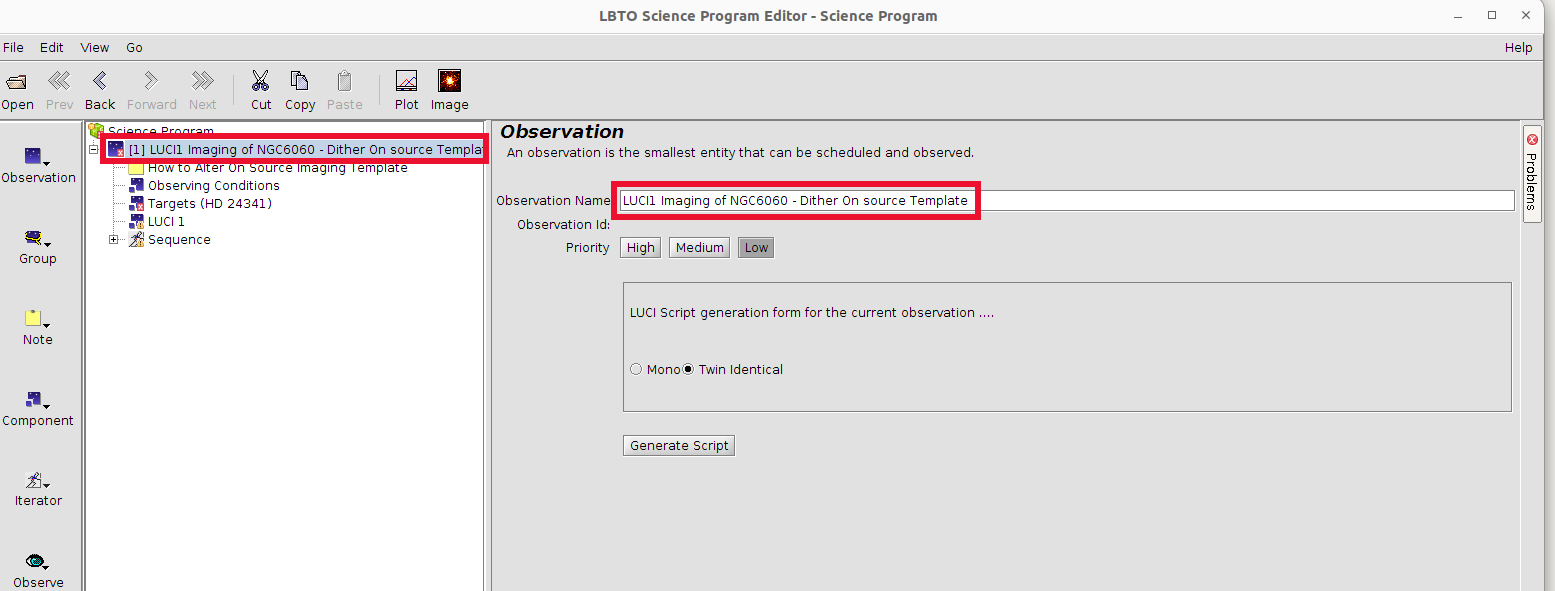
- Observing Condition Element: Complete the information in the Observation Conditions Element by selecting the nodes that roughly align with what was requested in your TAC proposal. These conditions are not guaranteed conditions and are not passed to the script in any way. Since Observing conditions information is not passed along in the Observing Scripts, it is important to not only pass along your complete scripts but this complete OT Program as well to LBTO and the Partner Coordinator. Details for exporting the OT are available here.
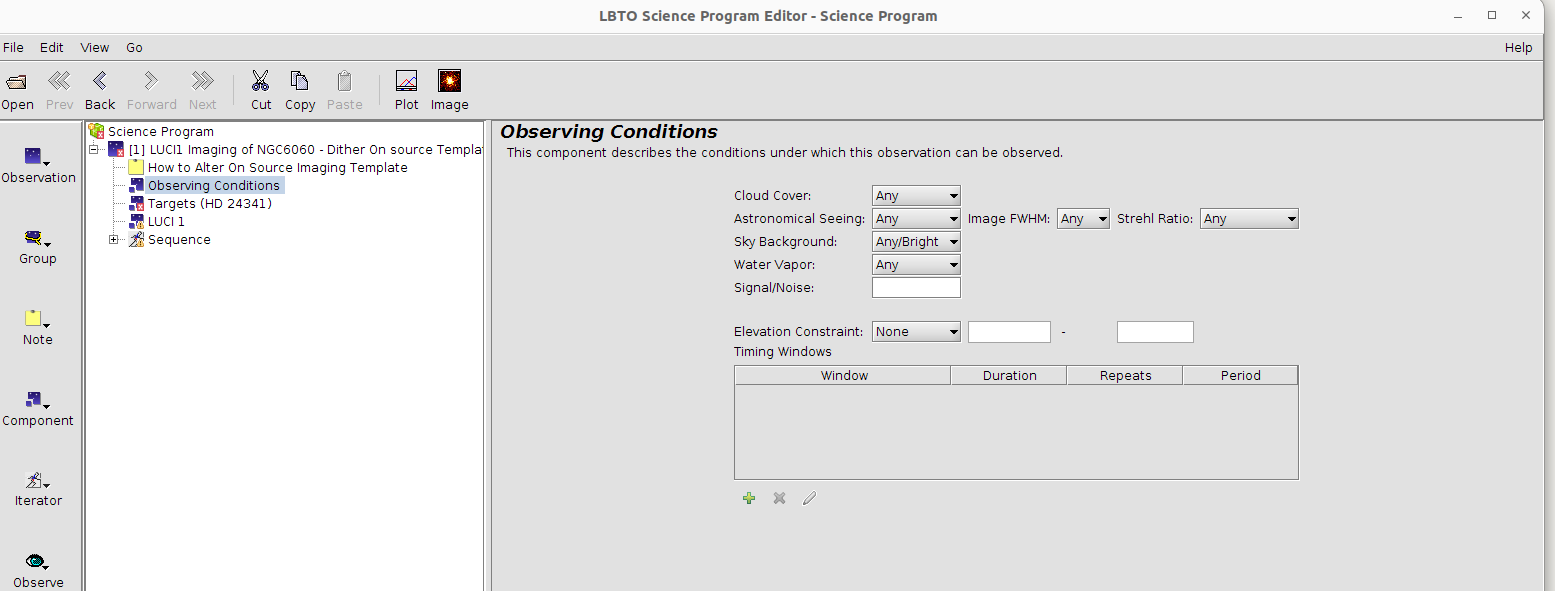
- Target Element: Enter Target. One can enter a valid SIMBAD Target Name and hit enter. If recognized, the coordinate field, magnitudes, and proper motion will populate. Or one can manually type in the Target Name, Coordinates, Brightnesses, and Proper Motion. In the Target Element the user can adjust the Position Angle and Telescope Mode of the observation. For SL observations, the Telescope Mode should be Active, for ESM it should be ESM, and for AO it should be Adaptive.
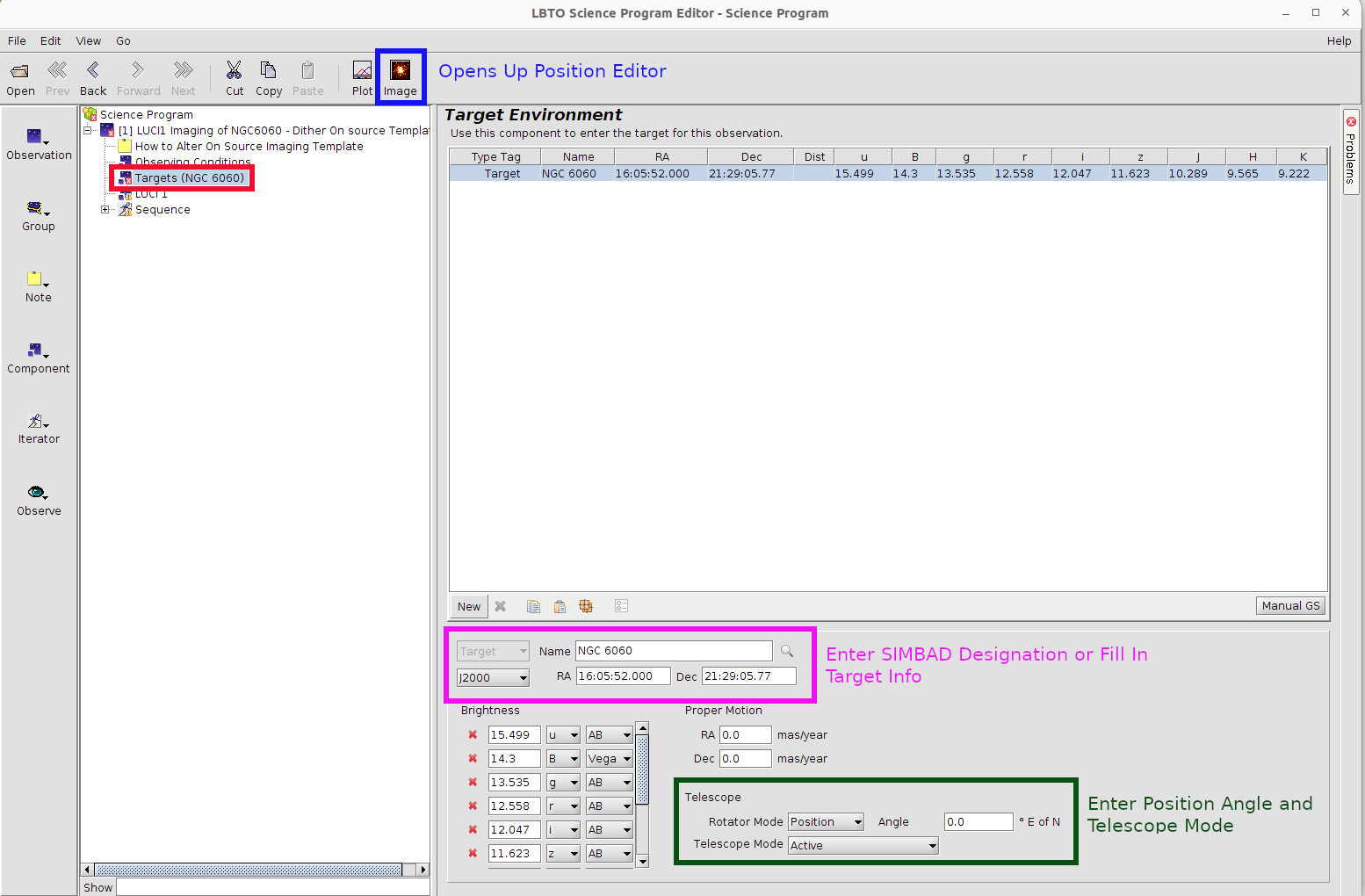
Click on the Image button in the Main Toolbar to bring up the Position Editor. The Position Editor will allow you to visualize the Target, as well as the the Guide Patrol Field, AO Patrol Field (for ESM/AO), and mask in use. This can be used to select a guide star. Details about guide/AO ref star selection can be found here. Any Offset pattern will also be overlaid. To bring up a default Catalog Image in the Position Editor, click on Image in the Toolbar in the Position Editor.
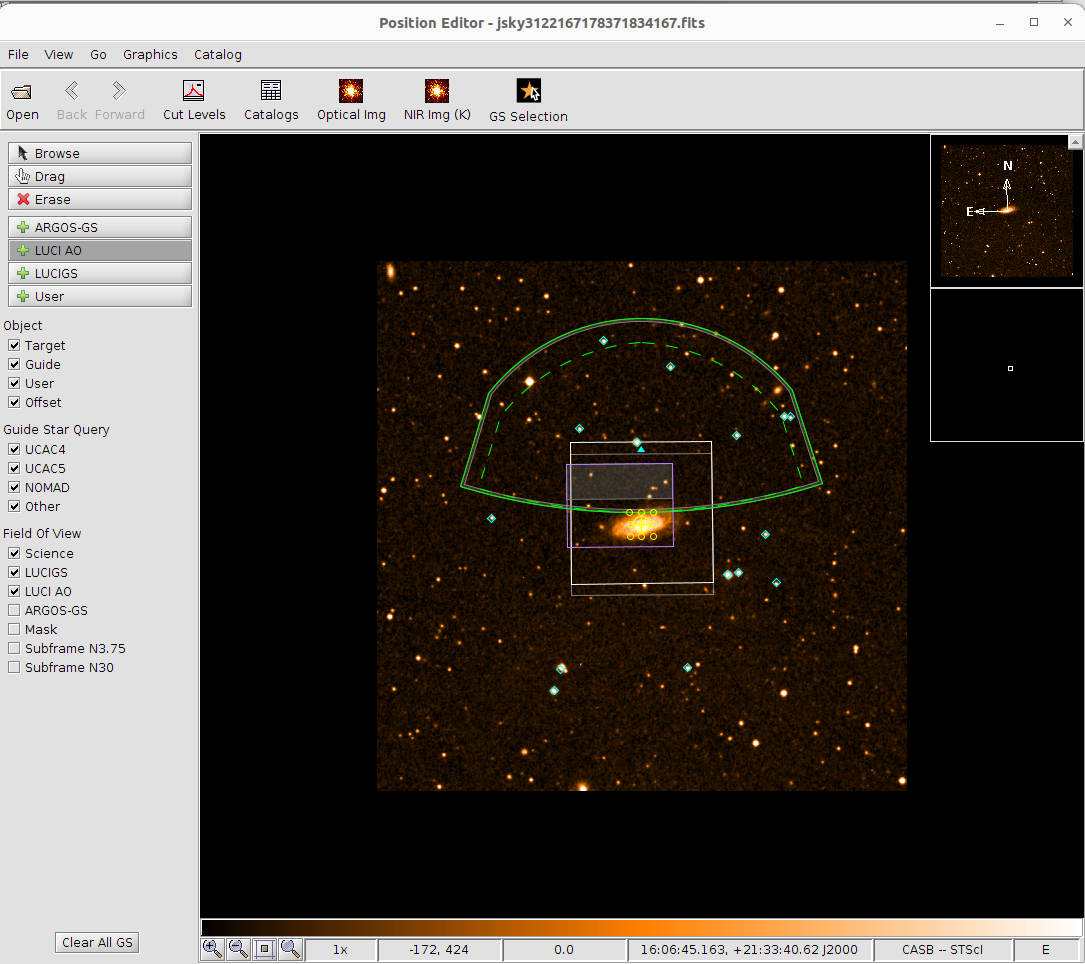
Select the desired elements in Field of View area to see overlays of the Guide Probe FOV (green), AO Probe FOV (purple) Science FOV and Masks (white, these often will come up by default). - Obtain a Guide Star. This can be done 2 ways.
- With Target Element: Select New in the Target Element. In the drop down menu, select LUCIGS (LUCI AO for an ESM/AO ref star) to create a new guide star element in the Target Environment. You will need to manually enter a valid SIMBAD designation or the RA DEC for the Guide star. This is a useful option is the guide star is previously known.
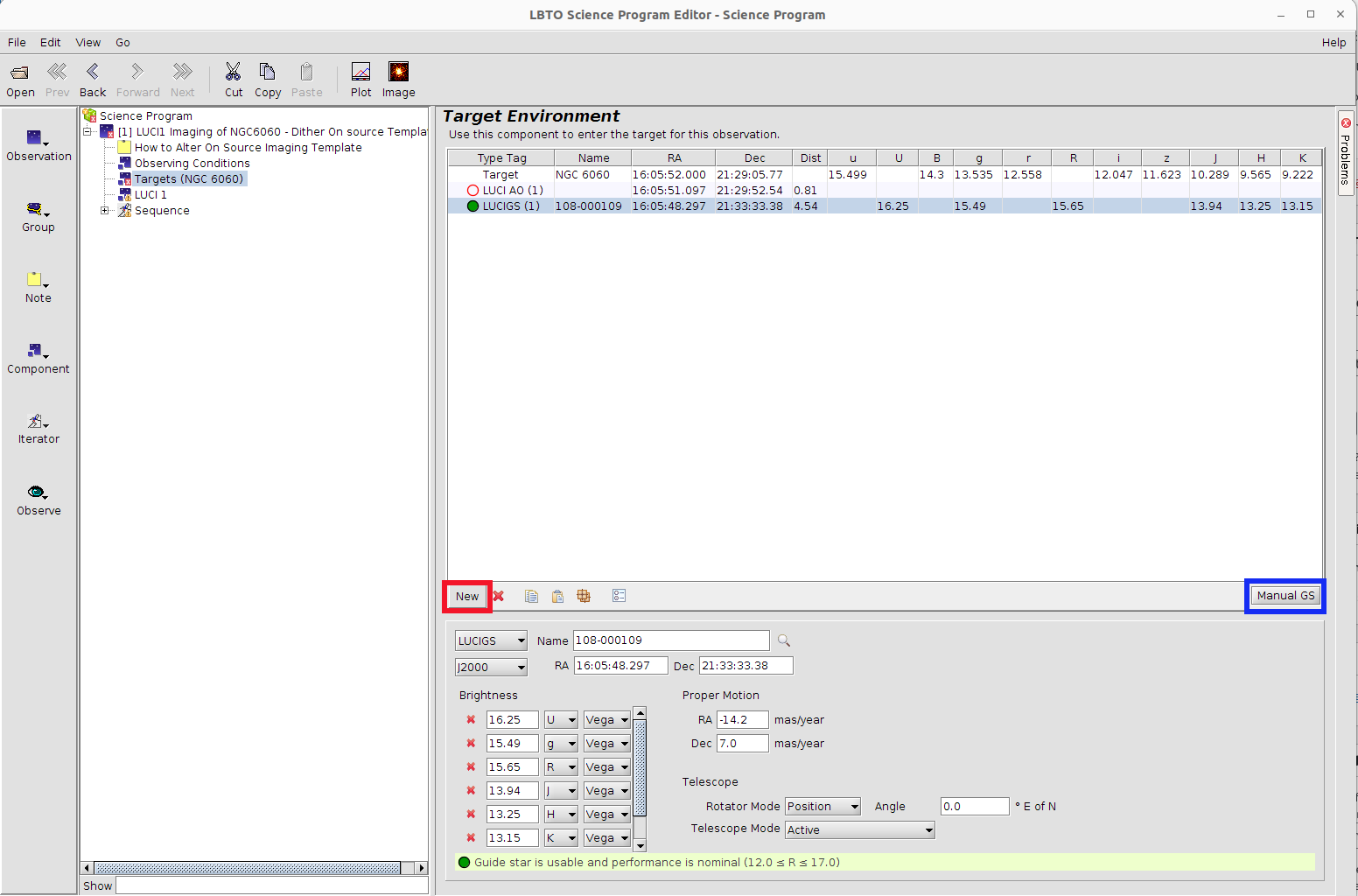
- With Position Editor: Click the Manual GS Button on the right of the Target Element. This will bring up the Position Element with a popup. In the popup you can select either the NOMAD, UCAC4, UCAC5, and Gaia catalog for your Guide Star options. Once you select ok, the catalog will be queried and the catalog stars will be highlighted in the Position Editor (green for NOMAD and turquoise for UCAC4/5/Gaia). Select the +LUCIGS (+LUCI AO) option on the Left Sidebar then click on guide stars that fall within your Guide Probe FOV. You will see an overlay of the physical probe footprint appear over the selected guide stars. This will allow you to see any vignetted area.
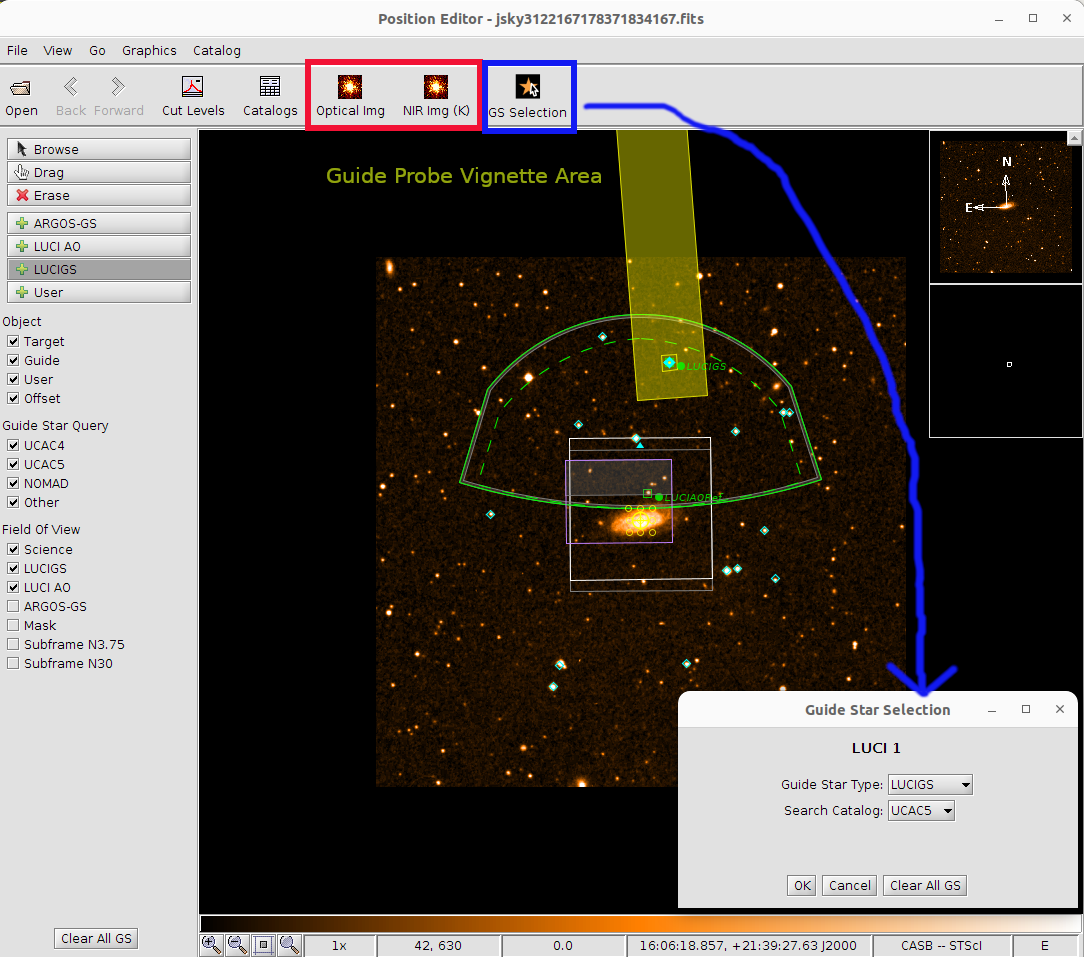
The selected stars will populate in the Target Element.
- With Target Element: Select New in the Target Element. In the drop down menu, select LUCIGS (LUCI AO for an ESM/AO ref star) to create a new guide star element in the Target Environment. You will need to manually enter a valid SIMBAD designation or the RA DEC for the Guide star. This is a useful option is the guide star is previously known.
- LUCI Instrument Element: This element will define the initial configuration of the instrument.
The LUCI Instrument Elements in the OT have many configurable components, included mechanisms and detector settings. There are slight differences between LUCI1 and LUCI2 cameras, gratings, and permanent masks that may prevent twinning. See the LUCI User’s Manual for a full description of available mechanisms and modes for both LUCI1 and LUCI2. The camera, disperser, and mask position are already set to the N3.75, mirror, and no mask in the library template (typical for seeing limited. Note that for AO observations, the N30 camera/field stop are used). Adjust the filter, DIT, NDIT, Nexp, save mode, and read mode to desired values of the initial observation.
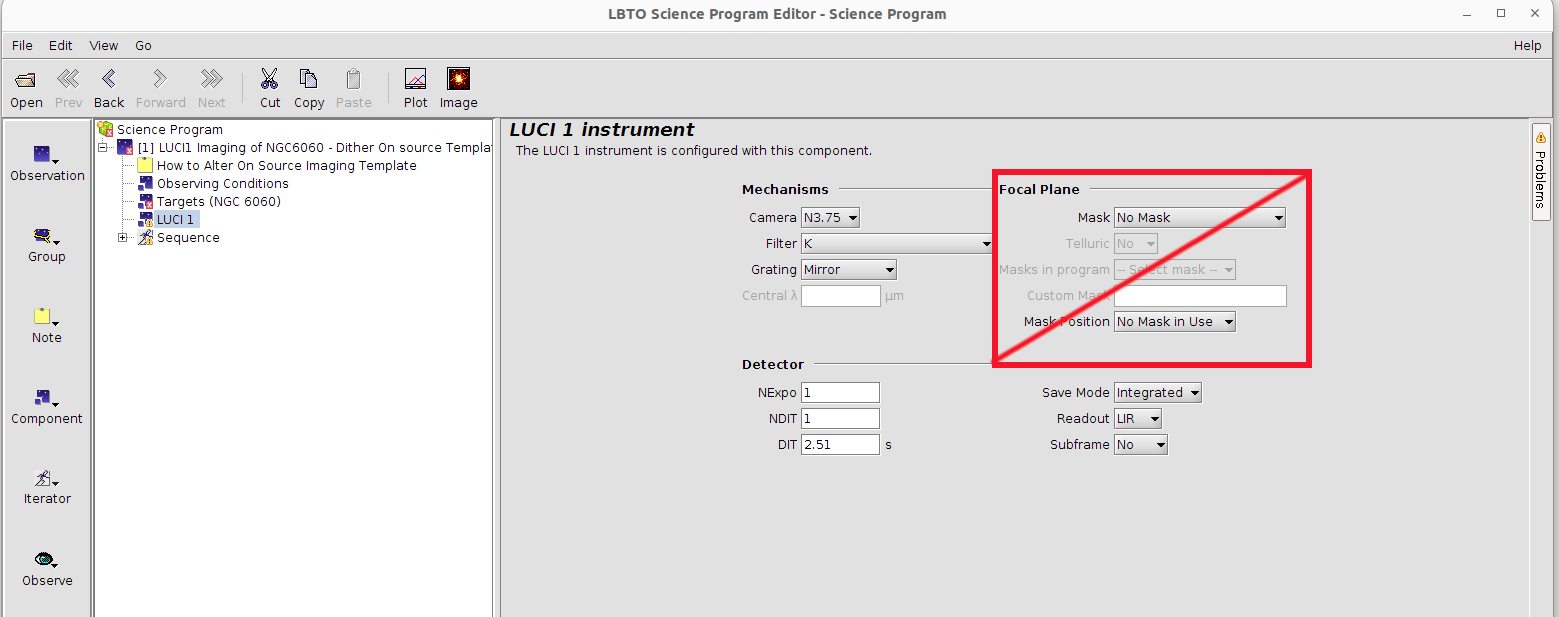
- Sequence Element: The LUCI Imaging Sequence is composed of 2 to 3 components: possibly a LUCI Sequence Iterator, an LUCI Offset Iterator, and an Observe Type. With Infrared Observing, dithering is necessary to remove the instrumental signatures and atmospheric background, so the LUCI Offset Iterator will always be present. A LUCI Sequence Iterator is only present if there is an instrument configuration change during the observation which is not always the case in imaging.
-
- Edit LUCI Offset Iterator: Use the Iterator Action Items (in red box above) to add, remove, or move offset positions. Add dither patterns using the Pattern Generators, such as the Dice5 shown above (purple), or upload a list from a local disk. Offsets can be adjusted by selecting the desired offset in the table, then entering the new value in the Selected Position(s) field at the bottom (green).
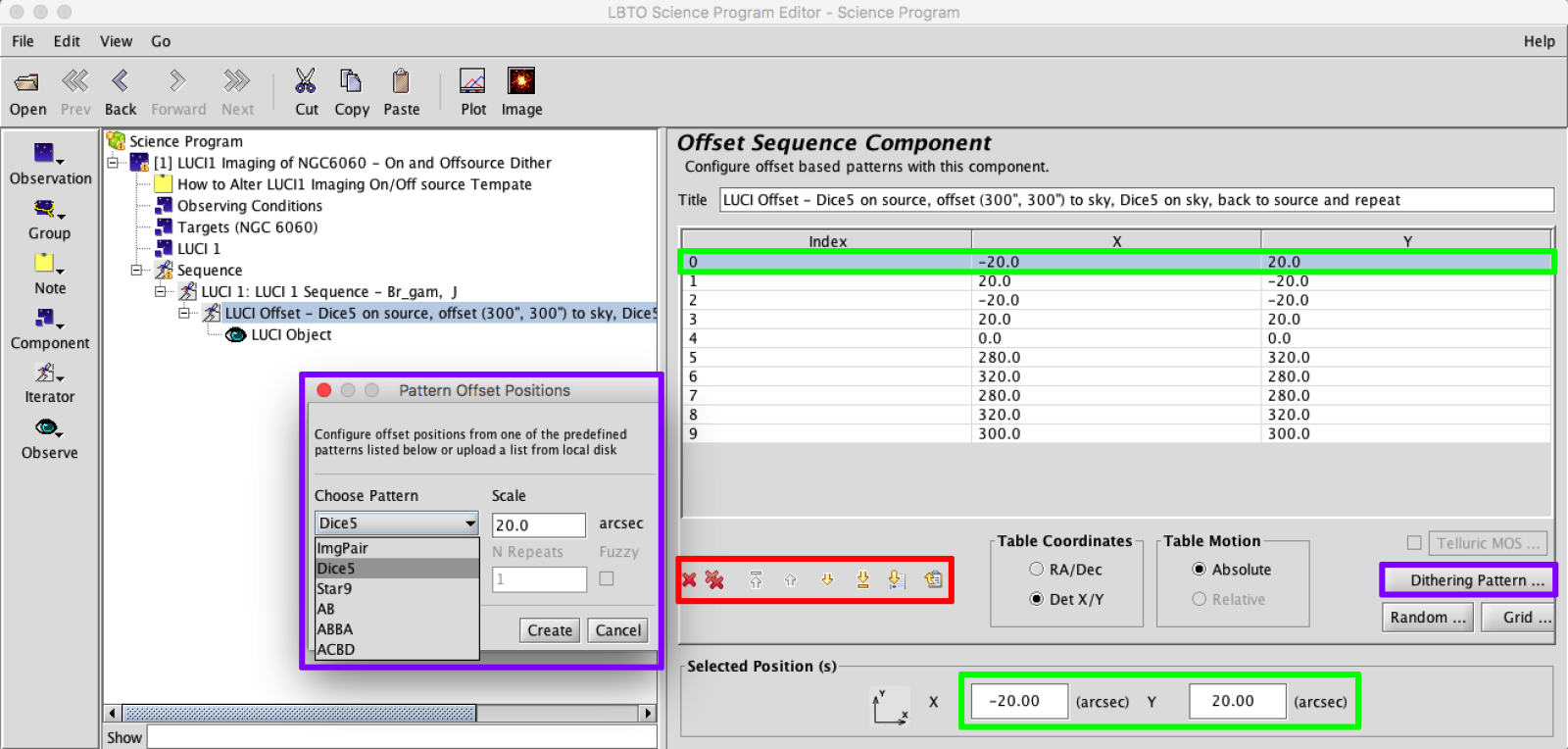
- Edit LUCI Offset Iterator: Use the Iterator Action Items (in red box above) to add, remove, or move offset positions. Add dither patterns using the Pattern Generators, such as the Dice5 shown above (purple), or upload a list from a local disk. Offsets can be adjusted by selecting the desired offset in the table, then entering the new value in the Selected Position(s) field at the bottom (green).
- Add/Edit LUCI Sequence Iterator: A sequence iterator is not present for all templates. To add an an instrument sequence iterator, add the LUCI Sequence to the Sequence by clicking the Iterator Bottom in the Left ToolBar and selecting LUCI N Sequence from the menu.
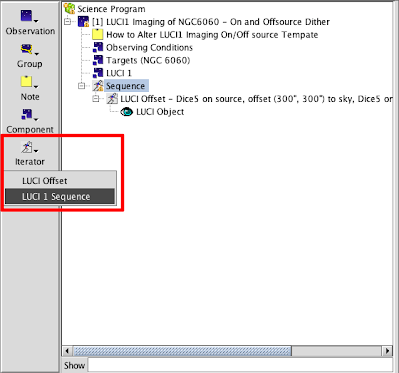
A blank LUCI Sequence Iterator will appear. Edit the sequence of filters, DITs, NDITs, Nexp, readmodes, and savemodes in the LUCI Sequence Iterator. The item values default to those set in the LUCI Instrument Element if not changed in the Sequence Iterator. For example, if the number of exposures is set to 4 in the LUCI Instrument Element, it will be set to 4 for all filter and NDIT x DIT combinations unless explicitly changed, even if the number of exposure item is not made visible in the Instrument configuration.
Edit the sequence of filters, DITs, NDITs, Nexp, readmodes, and savemodes in the LUCI Sequence Iterator. The item values default to those set in the LUCI Instrument Element if not changed in the Sequence Iterator. For example, if the number of exposures is set to 4 in the LUCI Instrument Element, it will be set to 4 for all filter and NDIT x DIT combinations unless explicitly changed, even if the number of exposure item is not made visible in the Instrument configuration.


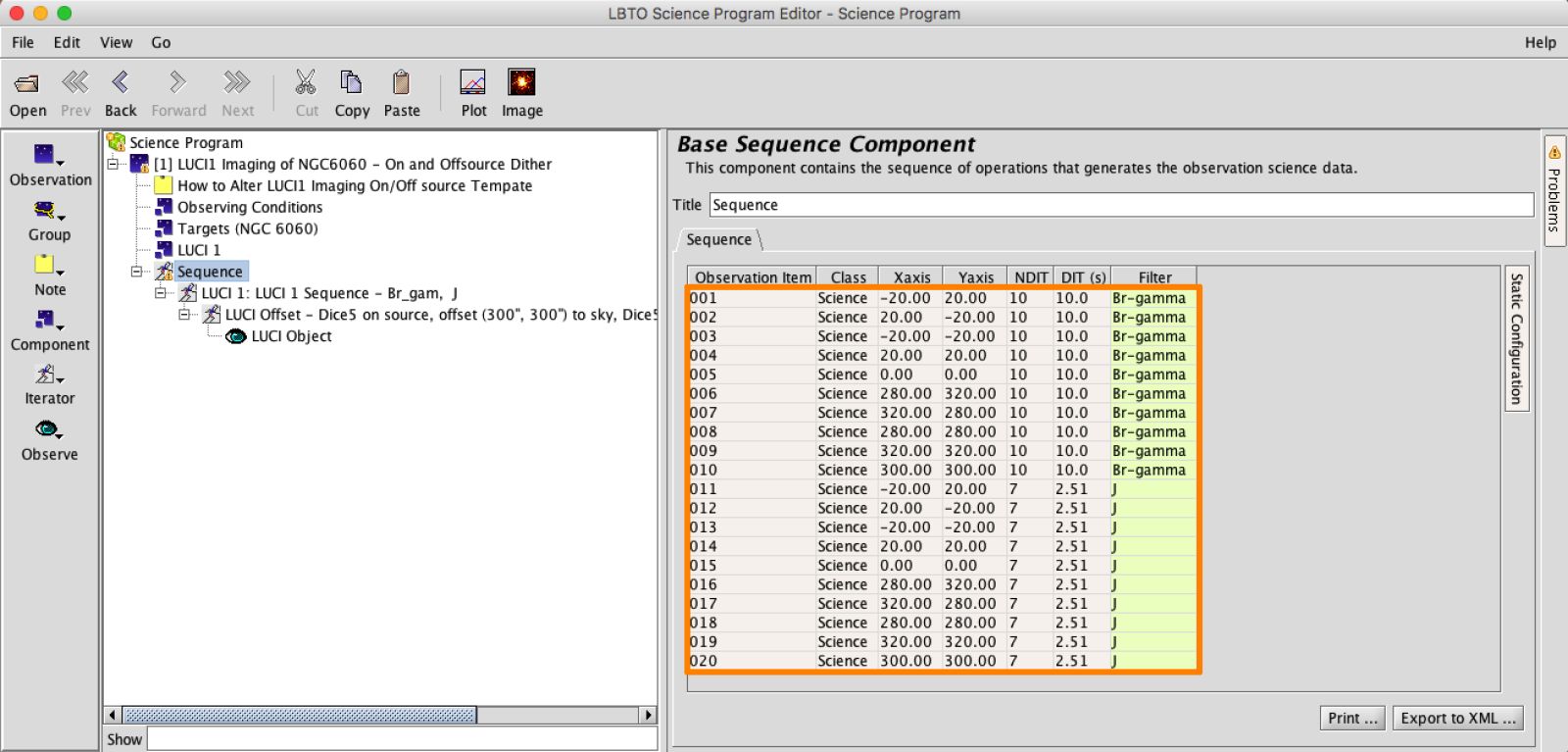
The order of the elements in the sequence can be adjusted by selecting the elements in the tree and dragging them. Rearrange the order of the Iterators in the sequence to always place the Sequence Iterator higher in the tree than the Offset Iterator, so that a complete dither pattern is completed in each instrument configuration.
- Observe Type: For Science Observations this will always be set to LUCI Object, Class Science. For Standard Stars you may change the Class to Standard.
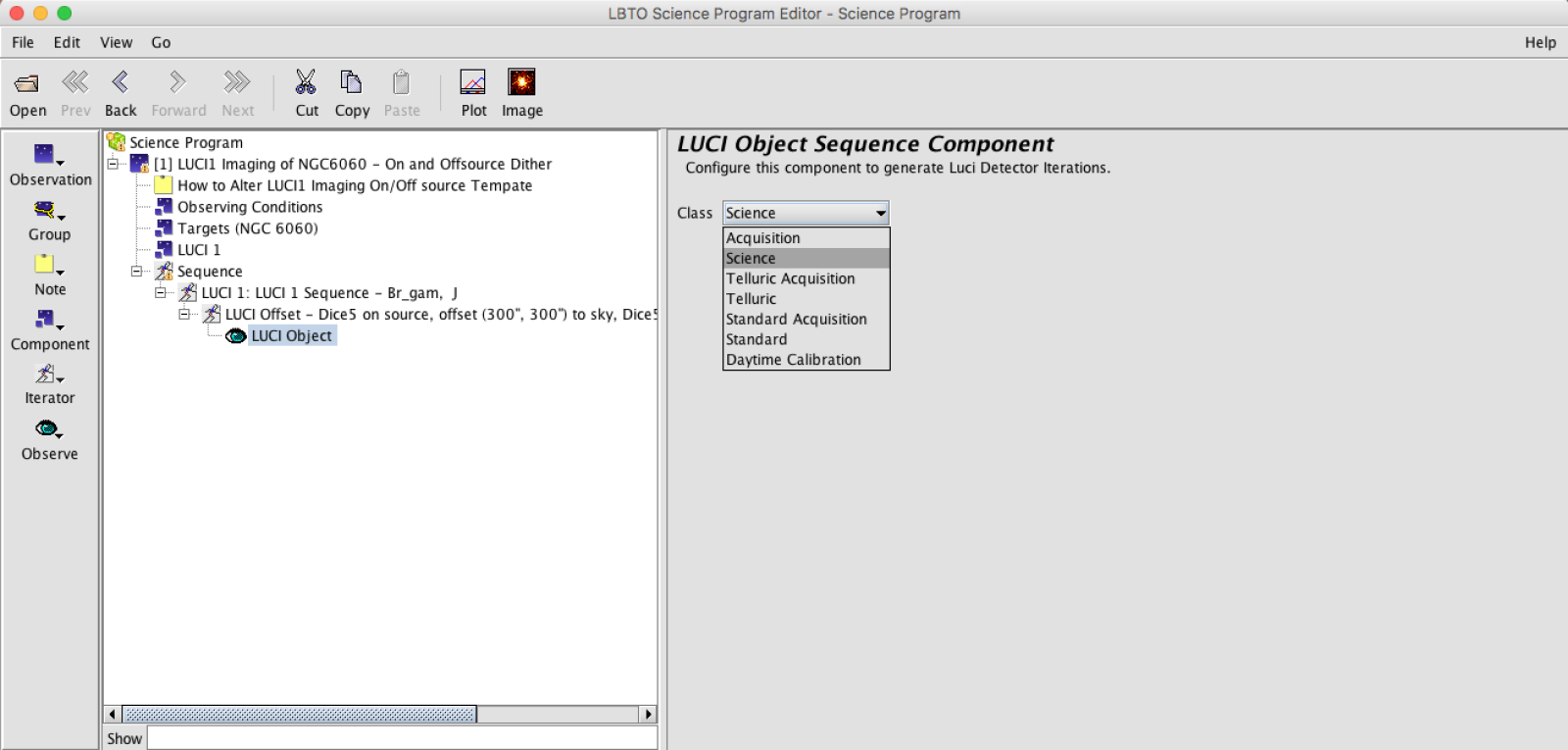
- Review and Generate Script: Once the above has been complete, the Sequence Element can be used to review Instrument and Telescope changes. Instructions for generating a script from the observation are available here.

